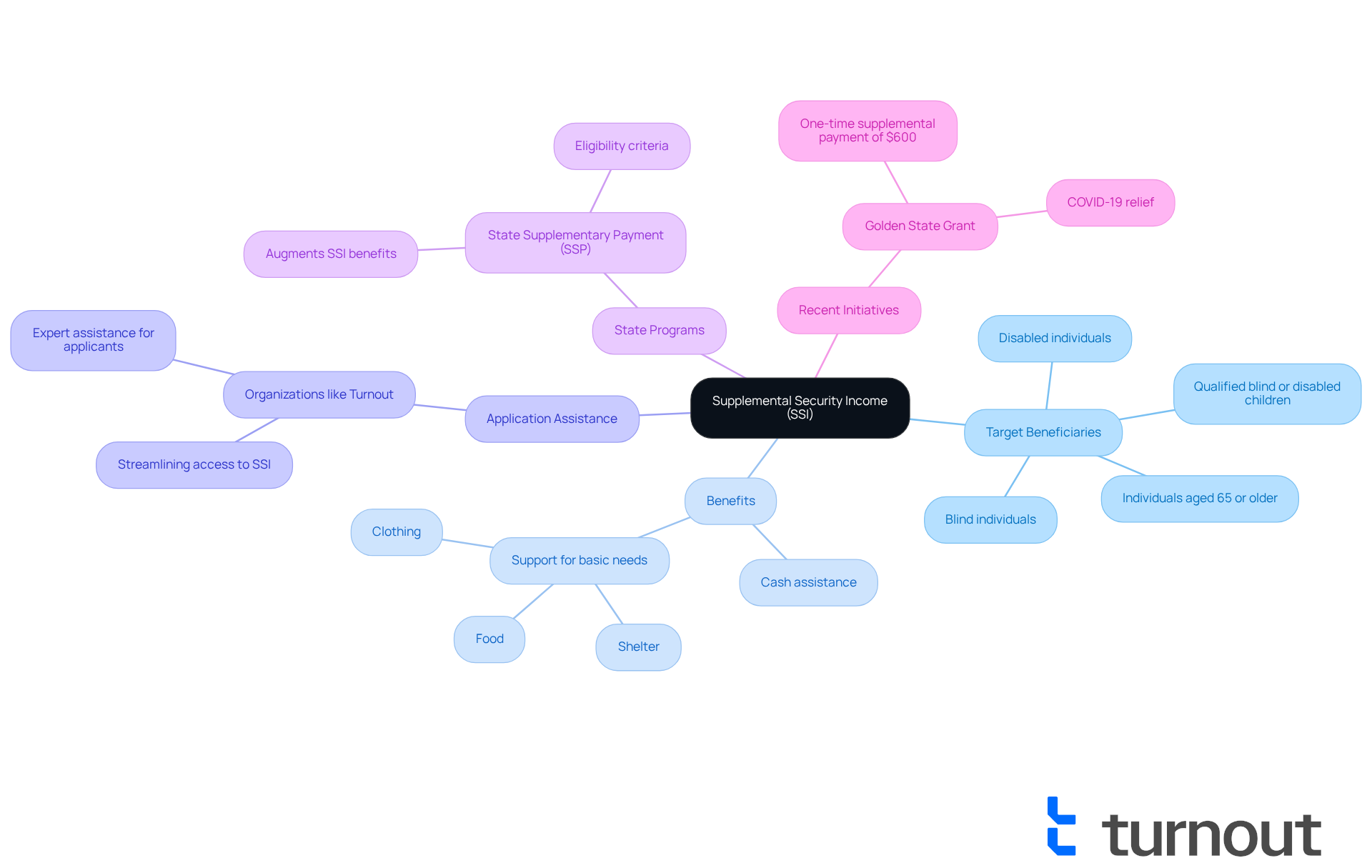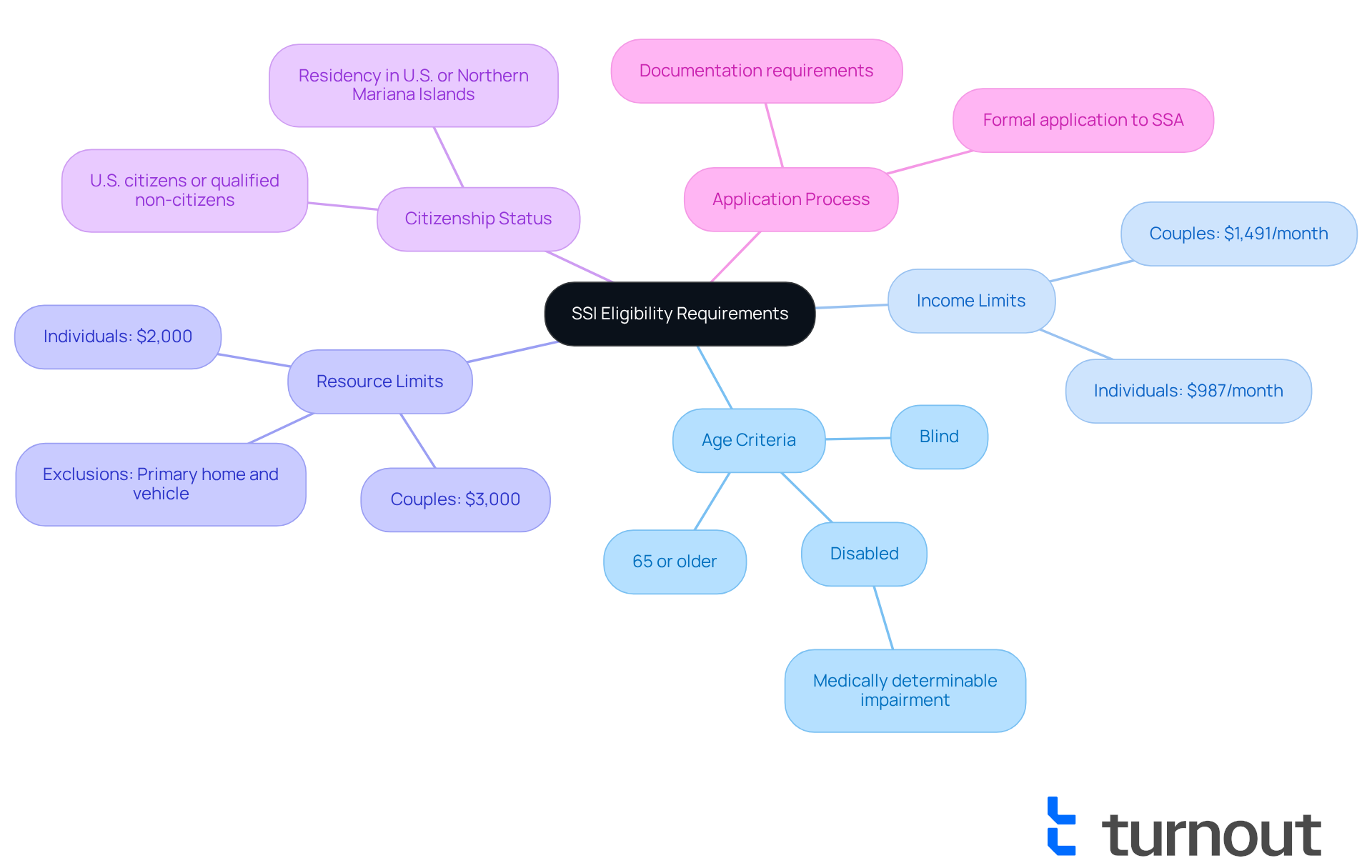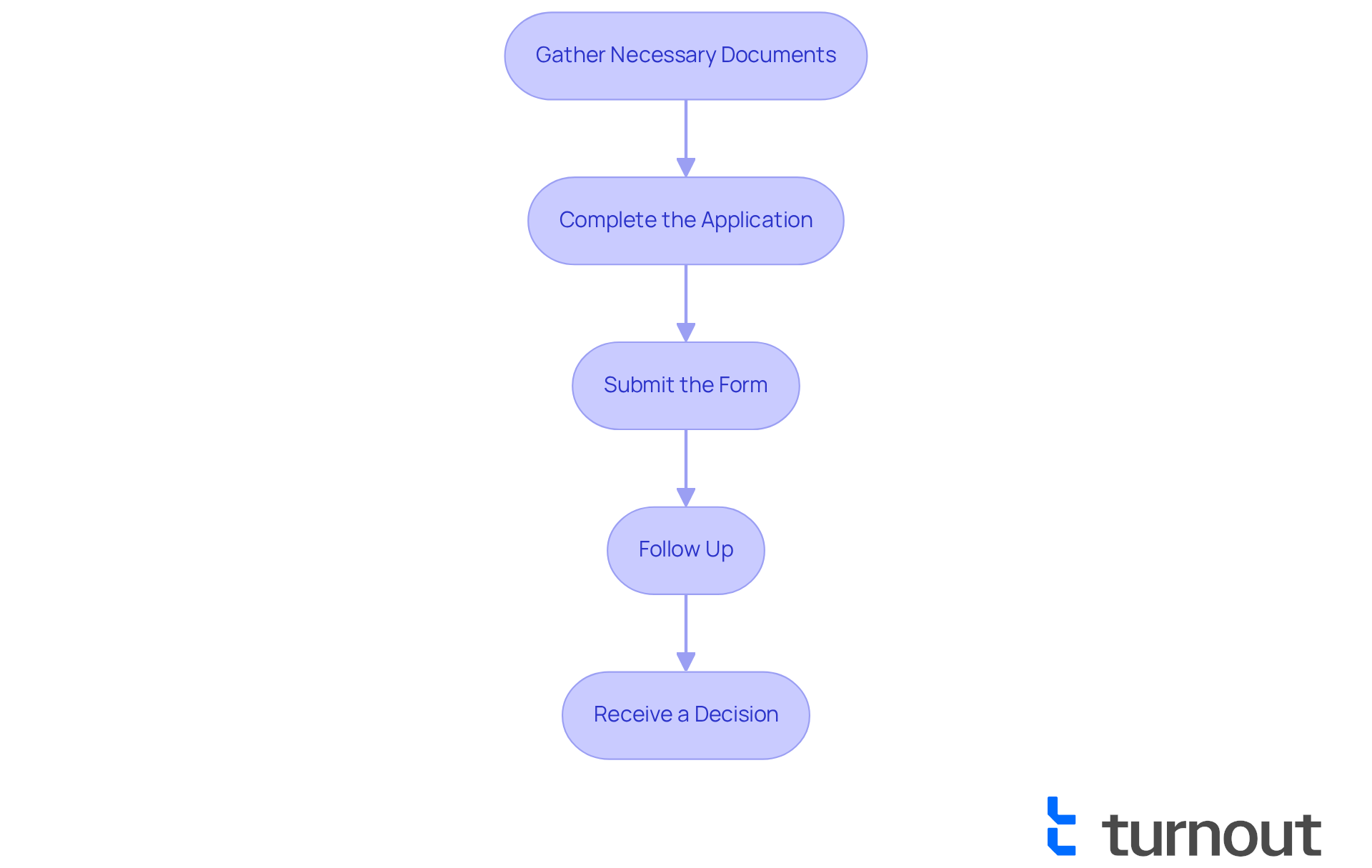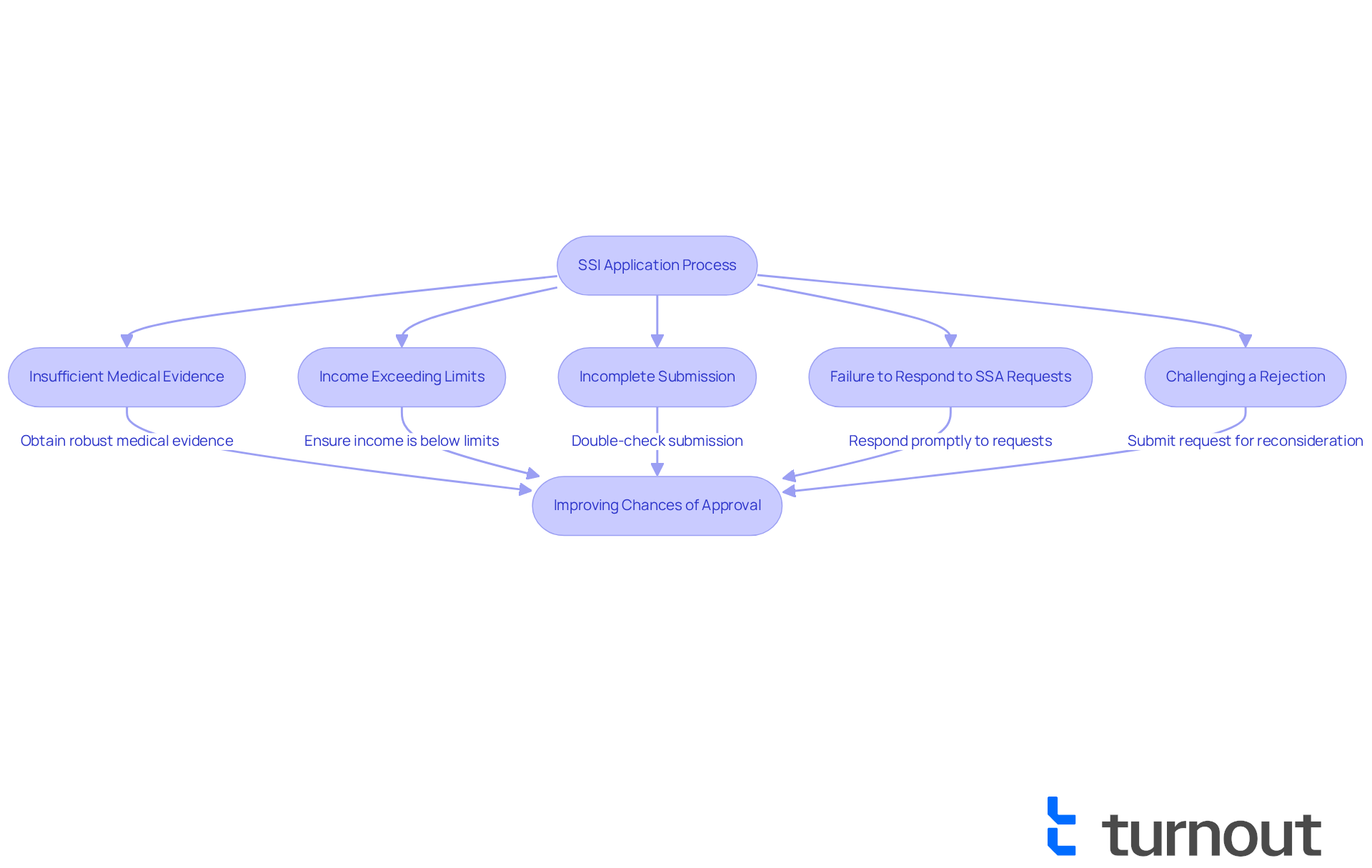Overview
Navigating the world of Supplemental Security Income (SSI) can feel overwhelming, especially when you’re unsure if you qualify. We understand that many people face challenges when it comes to understanding eligibility requirements. To help you, let’s break down who can apply for SSI.
To be eligible, you must meet the following criteria:
- Be aged 65 or older
- Be blind
- Be disabled
Additionally, there are strict income and resource limits that you need to be aware of. It’s essential to gather the necessary documentation and understand the application steps involved. This knowledge can make a significant difference in your experience.
We know that the application process can be daunting, but understanding these criteria is crucial. It helps you navigate the system more effectively and avoid common pitfalls that could lead to denials. Remember, you are not alone in this journey; we’re here to help you every step of the way.
If you have questions or need assistance, don’t hesitate to reach out. Together, we can work through this process and ensure you have the support you need.
Introduction
Understanding the complexities of Supplemental Security Income (SSI) is vital for millions of Americans seeking financial support. This federal program acts as a lifeline for individuals aged 65 and older, as well as those who are blind or disabled. Yet, many find themselves feeling overwhelmed by the eligibility criteria and application process.
With around 8 million beneficiaries relying on SSI to meet their basic needs, the stakes are incredibly high. We understand that it can be frustrating when deserving individuals encounter roadblocks that hinder their access to these essential benefits.
In this article, we’ll explore:
- Who can apply for SSI
- The specific requirements
- The steps necessary to successfully navigate the application process
Remember, you are not alone in this journey; we’re here to help ensure that no one has to face these challenges alone.
Define Supplemental Security Income (SSI)
Supplemental Security Income (SSI) is a vital federal program designed to provide financial support to individuals with limited income and resources. It primarily assists those aged 65 or older, as well as those who are blind or disabled. We understand that meeting basic needs like food, clothing, and shelter can be challenging, and SSI plays a crucial role in helping recipients navigate these difficulties.
As of 2025, around 8 million people benefit from SSI, highlighting its significance in reducing poverty among low-income groups. This program not only offers financial aid but also supports disabled individuals in managing everyday challenges. For instance, SSI benefits can help cover essential expenses, allowing recipients to focus on their health and well-being.
It's common to feel overwhelmed when trying to figure out who can apply for SSI to access these essential government benefits. That's where organizations like Turnout come in. They streamline access to SSI, providing expert assistance to help you understand who can apply for SSI and navigate the application process with ease.
In addition to federal support, many states offer supplementary programs, such as the State Supplementary Payment (SSP). If you qualify for SSI, you also qualify for SSP, ensuring that you receive the additional support you need. This partnership strengthens the program's impact on enhancing the quality of life for those at risk.
Federal regulations relevant to SSP are specified in 20 CFR §416.101 et seq. Recent initiatives, like the Golden State Grant, have provided one-time supplemental payments to SSI/SSP recipients, further alleviating hardship during tough times. Remember, you are not alone in this journey; we're here to help you find the support you deserve.

Identify Eligibility Requirements for SSI
Navigating the Supplemental Security Income (SSI) application process can feel overwhelming, but Turnout is here to help simplify it for you. Let’s break down the key requirements together:
-
To determine who can apply for SSI, you need to be 65 or older, blind, or have a disability that significantly impacts your ability to work. For instance, if you have a serious visual impairment or a condition expected to last at least 12 months, you might meet the criteria.
-
Income Limits: SSI has strict income limits. In 2025, individuals must have a countable income of less than $987 per month, while couples must stay under $1,491. It’s crucial to carefully calculate any income from work, Social Security benefits, or other sources to ensure you remain eligible.
-
Resource limits are important for understanding who can apply for SSI. The maximum asset limit is $2,000 for individuals and $3,000 for couples. This includes cash, bank accounts, stocks, and other assets, but your primary home and vehicle don’t count. Even small financial missteps, like giving away resources or selling them for less than their worth, can lead to ineligibility for up to 36 months. That’s where Turnout’s trained nonlawyer advocates can step in to help you navigate these complexities.
-
To understand who can apply for SSI, you must be a U.S. citizen or a certain type of qualified non-citizen, and you need to reside in the United States or the Northern Mariana Islands. Noncitizens have specific criteria to meet, and losing your noncitizen status can affect your benefits.
-
Application Process: You’ll need to submit a formal application to the Social Security Administration (SSA) to find out who can apply for SSI. This process can be daunting, as many applicants face challenges with the complex requirements and necessary documentation. Turnout offers resources and services to support you through this journey. While we’re not a law firm and don’t provide legal advice, our trained advocates are here to assist you.
Social workers and advocates often highlight the hurdles applicants face with these income and resource limits. It’s common to feel frustrated when strict criteria leave deserving individuals without the assistance they need. For example, a disabled veteran with limited income might exceed the resource limit due to savings, making them ineligible for SSI despite their urgent need for help.
Currently, around 7.5 million low-income Americans receive SSI benefits, which underscores the importance of understanding these eligibility requirements. Additionally, proposed rule changes could lead to benefit cuts or loss of eligibility for hundreds of thousands of SSI recipients, making it even more crucial to stay informed.
Remember, you’re not alone in this journey. We’re here to help you every step of the way.

Outline the SSI Application Process
Navigating the application process for Supplemental Security Income (SSI) can feel overwhelming for those who can apply SSI, but you’re not alone. We’re here to help you through each step with care and understanding.
-
Gather Necessary Documents: Start by collecting essential documents like proof of age, citizenship, income, and resources. If you’re someone who can apply SSI due to a disability, don’t forget your medical records. Did you know that around 7.5 million low-income Americans receive SSI benefits? It’s crucial to have accurate documentation, especially for individuals who can apply SSI, given the resource limit of $2,000 for individuals and $3,000 for couples.
-
Complete the Application: You can submit your application online via the SSA website, by phone, or in person at a local SSA office. It’s important to fill out every section accurately to avoid delays. Common mistakes include missing information or documents, which can slow down the process. If you need assistance, Turnout offers support through trained nonlawyer advocates who can guide you without the need for legal representation.
-
Submit the Form: After completing the form, submit it along with any required documentation. If you’re submitting online, follow the prompts carefully to ensure everything is processed smoothly. If you’re missing some documents, don’t worry! You can still submit your request and provide the remaining documents later, just be sure to indicate what’s outstanding.
-
Follow Up: Once you’ve submitted your application, keep track of your status. The SSA may reach out for more information or clarification, so be ready to respond promptly. Regular follow-ups can help resolve any concerns that arise during the evaluation. Staying informed about updates from the SSA and disability advocacy organizations is also vital during this time.
-
Receive a Decision: The SSA will evaluate your request and inform you of their decision, which can take several months. If you’re approved, you’ll receive details about your benefits and payment schedule. It’s essential to remain patient during this waiting period, as the initial decision can take anywhere from three to six months.
By understanding these steps and preparing the necessary documentation, you can navigate the SSI application process more effectively for individuals who can apply SSI. Remember, Turnout is here to support you every step of the way, ensuring you have access to the resources and guidance needed to navigate these complex systems. You are not alone in this journey.

Address Challenges and Denials in SSI Applications
Many candidates who can apply ssi encounter significant hurdles during the SSI submission process, which often leads to frustrating rejections. We understand that this can be disheartening, but knowing the common reasons for these denials can help you navigate the system more effectively.
-
Insufficient Medical Evidence: When applying based on disability, it’s crucial to ensure that your medical documentation robustly supports your claim. A lack of detailed medical records can lead to a denial of benefits. The Social Security Administration may assume that you could work if you had followed your doctor’s orders, complicating your claim further.
-
Income Exceeding Limits: The Social Security Administration (SSA) sets strict income limits for SSI eligibility. If your earnings exceed $1,260 monthly as an individual, you may be curious about who can apply ssi.
-
Incomplete Submission: Sending a request without all necessary information or documentation can lead to delays or outright rejections. It’s essential to double-check your documents for completeness before submission.
-
Failure to Respond to SSA Requests: If the SSA asks for additional information, responding promptly is vital. Ignoring these requests can lead to an automatic denial of your claim.
-
Challenging a Rejection: If your request is denied, remember that you have the right to contest it. Carefully review the denial letter to understand the reasons for the decision, and submit a request for reconsideration within 60 days. This process may require you to provide additional evidence or clarification to strengthen your claim.
In 2024, 62% of all requests for Social Security Disability benefits were denied at the initial stage. This statistic highlights the importance of addressing these frequent reasons for denial. Real-life examples show how inadequate medical evidence can impact SSI requests. Many applicants have faced denials due to a lack of comprehensive medical documentation, underscoring the necessity of thorough medical records in supporting claims. Disability advocates stress that robust medical evidence is essential for a successful submission for individuals who can apply ssi, as it greatly enhances the chances of approval.
Turnout, which is not a law firm and does not provide legal representation, offers valuable support in navigating these challenges. By employing skilled nonlegal advocates, Turnout helps clients prepare their submissions and ensure that all required documentation is organized. By recognizing these obstacles and preparing adequately, candidates can improve their chances of managing the SSI submission successfully.
Additionally, upcoming improvements to the SSI application process, including the introduction of a fully online, simplified iClaim application targeted for December 2024, may help alleviate some of the current challenges faced by applicants. Remember, you are not alone in this journey; we’re here to help.

Conclusion
Supplemental Security Income (SSI) is more than just a program; it’s a vital lifeline for those grappling with financial difficulties due to age, blindness, or disability. If you or someone you know might benefit from this support, understanding the eligibility criteria and application process is crucial. This article has highlighted essential aspects of SSI, including:
- Who qualifies
- The income and resource limits
- The steps involved in applying for benefits
We understand that navigating the eligibility requirements for SSI can feel overwhelming. It’s important to be aware of income restrictions and resource limits, as these factors can significantly influence your chances of receiving assistance. The application process can also be complex, with common challenges such as insufficient medical evidence or incomplete submissions. Resources like Turnout are invaluable, guiding individuals through these hurdles and ensuring you have the support needed to navigate the application successfully.
The significance of SSI truly cannot be overstated. It not only provides financial assistance to millions but also plays a vital role in enhancing the quality of life for those who are most vulnerable. If you’re considering applying for SSI benefits, remember that staying informed about eligibility criteria is key. Prepare thoroughly for the application process, and take proactive steps today. You deserve a more secure tomorrow, and we’re here to help you on this journey.
Frequently Asked Questions
What is Supplemental Security Income (SSI)?
Supplemental Security Income (SSI) is a federal program that provides financial support to individuals with limited income and resources, primarily assisting those aged 65 or older, as well as individuals who are blind or disabled.
Who benefits from SSI?
SSI benefits around 8 million people, particularly those who are elderly, blind, or disabled, helping them meet basic needs like food, clothing, and shelter.
How does SSI help recipients?
SSI provides financial aid that can cover essential expenses, allowing recipients to focus on their health and well-being while navigating everyday challenges.
How can individuals access SSI?
Organizations like Turnout assist individuals in understanding who can apply for SSI and help them navigate the application process.
Are there additional programs that support SSI recipients?
Yes, many states offer supplementary programs, such as the State Supplementary Payment (SSP), which provides additional support to those who qualify for SSI.
What is the relationship between SSI and SSP?
If you qualify for SSI, you also qualify for SSP, ensuring that you receive extra support to enhance your quality of life.
What federal regulations govern SSP?
Federal regulations relevant to SSP are specified in 20 CFR §416.101 et seq.
Are there any recent initiatives to support SSI/SSP recipients?
Recent initiatives, like the Golden State Grant, have provided one-time supplemental payments to SSI/SSP recipients to help alleviate hardship during difficult times.




